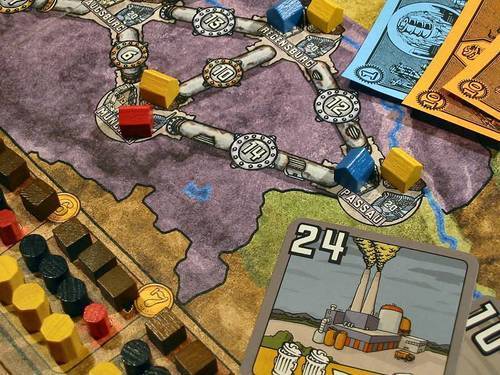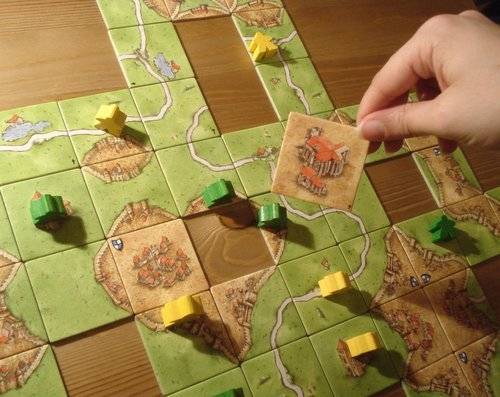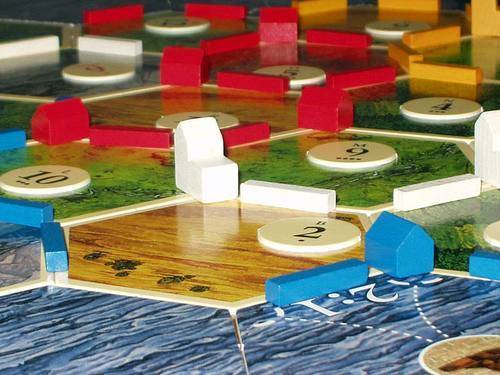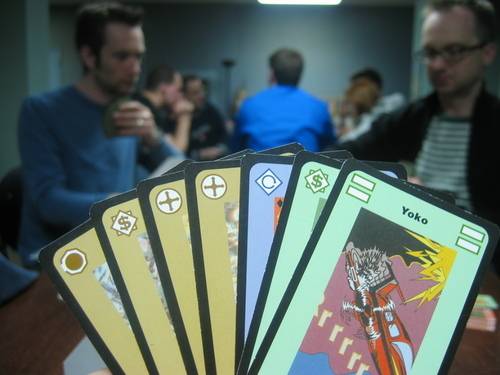 I’m pondering my next move. I have relied on coal and oil to fuel my power plants, but as my network of cities expands from Salt Lake City to Cheyenne to Duluth and beyond, the cost of uranium has dipped considerably. By upgrading my power plants to nuclear energy, I can power more cities with fewer resources at a lesser cost.
I’m pondering my next move. I have relied on coal and oil to fuel my power plants, but as my network of cities expands from Salt Lake City to Cheyenne to Duluth and beyond, the cost of uranium has dipped considerably. By upgrading my power plants to nuclear energy, I can power more cities with fewer resources at a lesser cost.
This is the name of the game in Power Grid, a board game designed in Germany and distributed worldwide. Its concept — the management of energy distribution and the consumption of natural resources — is very now, placing players in the position of solving an ongoing global issue on a smaller, approachable scale. There is no easy way to construct a massive power grid, but an abundance of strategies exist for budding energy czars who must negotiate a marketplace in flux.
Power Grid is but one of hundreds of adult-centric “Eurogames” — well-crafted, aesthetically appealing, and often complex board games created largely by German designers. Eurogames typically utilize specific, sometimes historic themes and often require players to focus on multiple tasks in one turn: resource management, route building, and live auctions, for example. Where American board games favor dumb luck and memory recall, Eurogames ratchet up the intensity with sophisticated strategies, layered phases, occasional collaboration, and frequent interaction.
Eurogames will not ask you to mold Play-Doh into recognizable shapes, a la Cranium. There may be a roll of the dice, but that is typically just one of many variables and not the entire means to an end. Downplaying the kill-or-be-killed mentality, Eurogames are constructed so that all players remain integral parts of the game until the end. The winner is usually only slightly more adept than the losers.
Finding Board Games Fun . . . Again
I first played Carcassonne, my favorite Eurogame, three years ago. It’s a medieval-themed tile-laying game that became a favorite of the board gaming world upon its debut in 2000. You probably haven’t heard of it, and you won’t find it at your nearest Wal-Mart. It, too, is a German game and, like Power Grid, is distributed in the States by Rio Grande Games and sold at select bookstore chains, in board game boutiques (like Dragon’s Table or Armored Gopher Games here in C-U), and on amazon.com.
Carcassonne takes its name from a massive walled city in southern France with origins dating back to 100 BC. The game’s creator, a German music/theology instructor named Klaus-Jürgen Wrede, was in his mid-thirties when he came up with the idea. Players draw tiles that are added to an existing footprint as if putting together a puzzle in which each piece has numerous ways of fitting. Every tile laid helps the players construct roads, cities, and cloisters (monasteries), which earn them points upon completion. Each game is different from the last, because the infinite flexibility of tile-laying always creates a new context from which to work.
 At the time of my introduction to Carcassonne, I was not familiar with Eurogames. Growing up, my older brothers and I played Risk, Battleship, and Stratego, games focused on warfare and direct conflict, both traits lacking from most Eurogames. Our hall closet had a shelf reserved for the likes of Hasbro, Parker Brothers, Mattel, and Milton Bradley, so I was well-versed in Uno, Clue, Life, and the sort. But as I entered adulthood, board games lost their hold on me. Despite the best intentions of party games like Apples to Apples, Pictionary, and Cranium, I was bored with board games.
At the time of my introduction to Carcassonne, I was not familiar with Eurogames. Growing up, my older brothers and I played Risk, Battleship, and Stratego, games focused on warfare and direct conflict, both traits lacking from most Eurogames. Our hall closet had a shelf reserved for the likes of Hasbro, Parker Brothers, Mattel, and Milton Bradley, so I was well-versed in Uno, Clue, Life, and the sort. But as I entered adulthood, board games lost their hold on me. Despite the best intentions of party games like Apples to Apples, Pictionary, and Cranium, I was bored with board games.
Carcassonne promptly changed that, reinvigorating a once-popular communal pastime while introducing fresh constructs into the mix. The depth of Carcassonne – such a simple game to learn, but one that allows for a variety of tactics and demands an adaptable strategy — kept me coming back. My obsession spawned a Sunday night ritual for three friends and myself: watching the latest episode of The Wire followed by a round or two of Carcassonne. Soon, I had purchased my own copy of the game, and then, one by one, all of the game’s expansion packs, each adding twists and turns to the gameplay of the original.
 Carcassonne led me to The Settlers of Catan, another sterling German game that has become the standard by which other Eurogames are measured. In 2009, Wired magazine profiled the game, calling it “perfect” and a “Monopoly killer.” Released in 1995, it helped pave the way for Carcassonne, which, like Settlers, was named Germany’s Game of the Year. Considering Germans purchase more board games per capita than any other nationality, such awards are handed out with no small amount of consideration. In fact, these games are so popular in Germany that the newspapers there actually employ board game critics.
Carcassonne led me to The Settlers of Catan, another sterling German game that has become the standard by which other Eurogames are measured. In 2009, Wired magazine profiled the game, calling it “perfect” and a “Monopoly killer.” Released in 1995, it helped pave the way for Carcassonne, which, like Settlers, was named Germany’s Game of the Year. Considering Germans purchase more board games per capita than any other nationality, such awards are handed out with no small amount of consideration. In fact, these games are so popular in Germany that the newspapers there actually employ board game critics.
Settlers, which is sold in the U.S. by the Skokie, Illinois-based Mayfair Games, took a while to catch on in the States, but has sold more than 15 million copies worldwide and is also available for the Xbox. Rio Grande, a New Mexico-based company that partners with European manufacturers to sell English-language versions of Eurogames, has sold more than 800,000 copies of Carcassonne and its various expansion packs.
Fighting for America’s Attention
Cerebral games have long held sway over the masses in foreign lands, but not in the U.S., where we tend to favor brainteasers, party games, and pop-culture shout-outs. Those of us who seek to solve multifaceted problems — or simply put our vocabularies and bottomless memory banks to use — have but a few trusty fallbacks in the form of Scrabble, Trivial Pursuit, chess, and the like.
And then there’s Monopoly, a game that has seen its brand borrowed countless times in thematic variations ranging from university campuses to Star Trek. A straightforward game of capitalism masked as real estate speculation, Monopoly is America’s standard-bearer. It formally dates back to the Great Depression, when a Philadelphia heater salesman named Charles Darrow patented it. Darrow’s version of the game was, in fact, a rendition of The Landlord’s Game, which was fashioned three decades earlier by Elizabeth Magie. (Magie was born in the central Illinois town of Canton.) Both Milton Bradley and Parker Brothers initially rejected Monopoly, finding it to be fundamentally flawed, but Darrow persisted, manufacturing and distributing the game himself until sales in the Philly area were strong enough to warrant reconsideration from Parker Brothers, who acquired the patent in 1935.
While Monopoly has gone on to become the most successful game in U.S. history, selling more than 200 million copies worldwide, the randomness of its gameplay — dice rolling and card selection — places it in stark contrast to other prestigious games linked to distant cultures and continents. The oldest game in the world is believed by some to be Oware, or Bawo, an African game whose name changes depending on the region of the continent. Its rules are so intricate that numerous books have been published to explain them.
Like Oware, the Chinese game Go has an uncertain origin. Some speculate that it dates to at least the 4th century BC. The rules of Go are relatively simple, but the strategy of capturing an opponent’s stones is complex. While its board and pieces resemble a larger checkerboard, it is far more abstract and challenging than checkers; it is a game to which chess masters graduate.
Go and Oware were games played by the social elite that eventually made their way to the masses and are still popular today. By comparison, the lack of intricacy in American board games is curious. While the wargames that became popular in the U.S. during the 1960s and ’70s feature more complex gameplay, many are now either virtually extinct (Squad Leader, Battle of the Bulge, Stalingrad) or remain confined to a cultish following (Axis & Allies, Warhammer). Two wargames that did find significant crossover appeal — Risk and Stratego — were not designed by Americans; they are, in fact, originally Eurogames. Risk was created by a Frenchman in the 1950s; Stratego was thought up by a Jewish man in hiding during the second World War. (To little surprise, German game designers shy away from wargames, which tend to center on the first or second World War.)
But the relative lack of serious titles on the shelves of American retail outlets has not slowed the growth of adult-oriented board games in the U.S. in the past decade. While children snub analog games for their video counterparts, games created for adults and families, like Cranium and Apples to Apples, have achieved immense success. According to a 2007 article in BusinessWeek, “games for adults are where the action is,” and top toymakers are seeing dramatic growth in the category. This would lead some to believe that a window is opening for Eurogames, because their primary targets are adults and families. Yet American adults, at least according to the big American toymakers, don’t appear to have the attention span or the time to play more involved games. In the same article, Hasbro COO Brian Goldner is quoted as saying: “Many parents find the prospect of spending over an hour playing… games quite daunting.” Hence, Hasbro introduced “express” versions of Monopoly, Sorry, and Scrabble, intended to take no more than 20 minutes. By comparison, a game of Settlers of Catan could stretch to two hours or longer.
“I am not certain games like Power Grid will ever find a wide audience due to their length,” adds Jay Tummelson, president of Rio Grande Games. “However, the vast majority of Eurogames play in less than an hour, including Carcassonne. Such games do have a [widening] appeal, and we are seeing that in the constantly increasing sales… I am particularly pleased with the interest [these games] have generated amongst families.”
Perhaps Goldner should reconsider his target demographic. If my group of board-game-loving friends — a recently-converted crew of graduate students, engineers, professors, designers, and editors — are any indication, the “creative class” is ready and willing to spoil his hypothesis while contributing to Tummelson’s profit margin. We’ve made the leap past Go and we aren’t looking back.
Bonus Round
Here’s a quick rundown of five Eurogames that may interest you.
The Settlers of Catan
OBJECT: Be the quickest to successfully settle your portion of an uncharted island by stockpiling resources – wood, grain, wool, ore, brick – that help you build settlements, roads, and even an army. Lumber and brick will help you early on, but if you want to win, you’ll need to mine some ore.
BEWARE: The roving thief, who only wants to weaken your stash of resources.
MECHANICS: Dice rolling, route building, commodities trading – all on a board that is randomly constructed at the start of each game to ensure that no two games are alike.
TIME: 90-120 minutes.
VERDICT: It’s considered by many critics to be among the finest examples of the Eurogame – with good reason.
 Modern Art
Modern Art
OBJECT: Through constant auctioning, players buy and sell artwork in the hopes of becoming the richest art dealer at the table. Players decide which artists to push, determining whether the pop art of Yoko or the abstract paintings of Karl Gitter will be the season’s hottest commodity.
BEWARE: Fixed-price auctions where you set the price. If no one agrees with your high price tag, you could end up footing the bill to purchase the painting you hoped to sell.
MECHANICS: Various styles of auctions, from round robin to sealed.
TIME: 45 minutes.
VERDICT: Designed by Eurogame god Reiner Knizia, the quick-paced Modern Art can be a blast if you’re in the right company. The five artists represented in the game may be make-believe and their art of questionable taste, but who isn’t intrigued by the idea of becoming a tastemaker who must flip pricey paintings? Last year, Masters Gallery, a variation of Modern Art, was released and features the artwork of legendary painters like Degas, Renoir, and Van Gogh.
1960: The Making of the President
OBJECT: In this two-player game, JFK battles Nixon for all the marbles. After choosing ideological sides, players work the political machine to gain leverage on contested issues, control the media, and ultimately steal electoral votes from the opposition. The game board reflects the 1960 electoral map and each player begins with slight, historically accurate edges in certain regions. It looks odd to see the South awash in Democratic blue and the Pacific Coast all red to start the game.
BEWARE: History — we know how this election really turned out, but this is Nixon’s chance to rewrite the books.
MECHANICS: Players must wisely manage the cards in their hands and always think several moves ahead.
TIME: 90-120 minutes.
VERDICT: The historical detail in this game is remarkable, making it almost as informational as the book of the same name. The game play is at times tedious — just like running a campaign — and the momentum swings frequently, but the player with the most foresight usually wins a trip to the Oval Office.
Agricola
OBJECT: In this complex game, players start with a small plot of land, a shack, and a spouse. They must harvest crops, raise animals, and generate offspring (extra farmhands) if they hope to out-farm their neighbors. The player with the most productive farmstead earns the right to pose “American-Gothic” style in front of the losers.
BEWARE: The rule booklet — it’s thick and intimidating. Online tutorials can help give you the gist of the game, though, and there’s an easier version for beginners.
MECHANICS: Players manage resources and take various courses of action in this turn-based game.
TIME: 120-plus minutes.
VERDICT: It’s not ideal for easily overwhelmed newbies, but Agricola is one of the highest-rated board games and an intriguing option for the non-corporate soybean farmer in all of us.
Ticket to Ride
OBJECT: Complete train routes from one city to the next across the USA, circa 1900. Attempt to go coast-to-coast for the most points, or play it safe by completing shorter routes throughout the Midwest and along the East Coast.
BEWARE: Procrastination — wait too long to claim routes in congested portions of the board and you’ll find yourself with one painfully long detour in your future.
MECHANICS: Collecting color-coded cards that allow players to complete the trek from Point A to Point B.
TIME: 60 minutes.
VERDICT: An incredibly easy-to-learn “gateway” game for Eurogame beginners and families, this Game of the Year winner in Germany comes in several variations, including one where players traverse the European continent.
For more info on these games — and countless others — visit boardgamegeek.com, the best online resource for board-gaming enthusiasts.
—
This article was originally published in art & society magazine, online at peoriamagazines.com.








